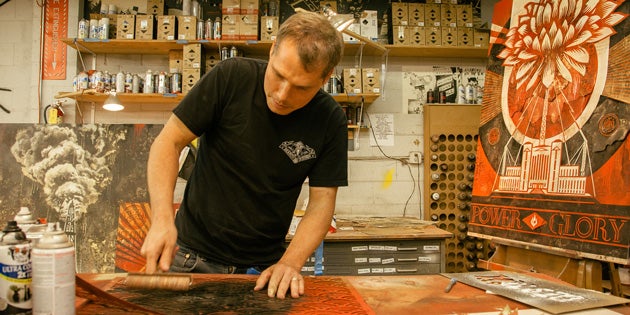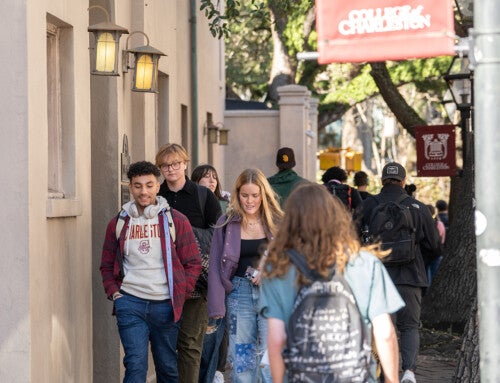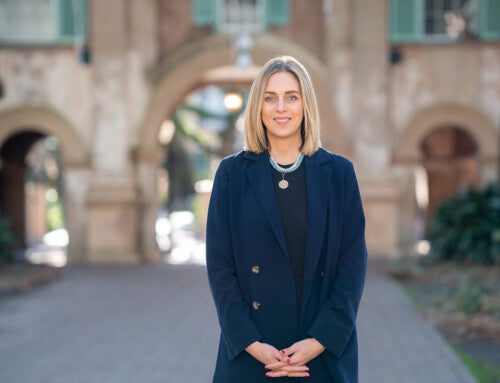Internationally renowned street artist and Charleston-native Shepard Fairey will visit the College of Charleston on May 15, 2014, to discuss his upcoming exhibition in the Halsey Institute of Contemporary Art.
The exhibition, The Insistent Image: Recurrent Motifs in the Art of Shepard Fairey and Jasper Johns, pairs new work by Fairey and a survey of prints produced by Jasper Johns. The exhibition runs May 22 – July 12, 2014.
 Fairey, who lives in Los Angeles, recently took a break from his busy schedule to answer a few questions for The College Today.
Fairey, who lives in Los Angeles, recently took a break from his busy schedule to answer a few questions for The College Today.
Q: Are there one or two places in downtown Charleston that are particularly meaningful to you and the development of your artistic style and thinking? Where are these places and why are they important to you?
A: I grew up downtown, and I always found inspiration in the historical architecture – columns, wrought iron, and manicured gardens were great material for drawing and painting. In a different way though, the decaying parts of downtown were inspiring as well. There was an abandoned swimming pool at the corner of George Street and Meeting Street that was an oasis for skateboarders and other creative delinquents. When I got into photography at the end of high school, I also loved to photograph abandoned properties being overtaken by nature on upper King Street.
Q: Among your body of work are two iconic images that helped define two different generations. In the early 1990s, “Andre the Giant has a Posse” stickers were ubiquitous around the country, including on the College of Charleston campus. But college students today, born in the mid-1990s, are more likely to associate you with your 2008 Obama “Hope” poster. Do you find this to be true? As you get older, what does it feel like to know you have had that kind of lasting impact on our culture?
A: The “Andre the Giant has a Posse” and Obey campaigns started before the Internet, so it was important to spread the campaign as actual physical art. I looked at it like a fun, viral, punk-rock chain letter that I could circulate through creative subcultures, but I never expected it to catch on the way it did. I learned a lot about the psychology of image absorption from the Obey campaign. As the Obey campaign became more political, especially after George Bush was elected and the Iraq war began, I thought about the problem of only critiquing negative things rather than supporting positive things. This was one of the reasons I created the “Hope” poster in 2008. I saw Obama at least in the way he positioned himself at that time, as the antithesis of Bush. It made sense to me to sincerely get behind someone I thought could transform the direction of politics for the better. I’m glad that poster resonated and proved that grassroots activism can make a difference even when the system is geared to favor the elite. I am not happy with everything about Obama’s presidency, but I think that the “Hope” poster is still something that could encourage the average person to use all of their skills to impact the democratic process. Apathy is the enemy.
 Q: You get invites to do exhibitions all over the world. Beyond the fact that Charleston is your hometown, what made you want to do the exhibition with Jasper Johns at the College’s Halsey Institute?
Q: You get invites to do exhibitions all over the world. Beyond the fact that Charleston is your hometown, what made you want to do the exhibition with Jasper Johns at the College’s Halsey Institute?
A: Jasper Johns is one of my all-time favorite artists, so it is an incredible honor to show alongside him, and I think that the work I created for the show has some conceptual connection to works that he did and ideas he had. In a way, the timing was serendipitous because a lot of my work was moving in the direction of addressing the pros and cons of power, glory, and America. This show just amplified my focus. Showing with the Halsey is great because they championed my work when I was far less established, and I like to be loyal to those who have supported me, and I also think it’s a great opportunity to show how my work has evolved in the last dozen or so years. Plus I get to hang with my parents and old friends.
RELATED: Read an article about the Halsey exhibition in Charleston Magazine.
Q: We understand you’ll be doing a mural project on the College of Charleston campus during your upcoming visit. What can you tell us about your plans for this project?
A: The mural I’m doing on the College of Charleston campus is a pro-green energy piece. When attaining permission for murals, it is much easier if the image has a positive slant. Sometimes the challenge is to say what I want to say visually and politically while still dealing with bureaucracy. Fortunately, this mural was approved and allows me to say what I’d like to say. A lot of the work in my show is about the negative side of power and glory, but this mural is about a positive kind of power that I think is the path to future glory.
 Q: Living in L.A., how closely do you follow what’s going on in Charleston these days in terms of its growth and international popularity, particularly in the tech sector and creative professions? Do you see Charleston one day becoming a cultural and artistic hub for young people and could you ever see yourself setting up shop back in your hometown?
Q: Living in L.A., how closely do you follow what’s going on in Charleston these days in terms of its growth and international popularity, particularly in the tech sector and creative professions? Do you see Charleston one day becoming a cultural and artistic hub for young people and could you ever see yourself setting up shop back in your hometown?
A: I do follow what’s happening in Charleston because I still have friends and family there. Food has always been great in Charleston, but I’m delighted to see that it is now being embraced by culinary sophistos. The art scene in Charleston has some great people and things happening, but I still think there needs to be more contemporary art galleries. Tech is not my specialty, so I’m a bit ignorant about how that is developing. One thing I think technology has been great for is allowing artists and designers to work from almost anywhere. I enjoy Los Angeles, but there are many aspects of Charleston I miss. I could see living there, at least part of the time, in the future. My wife and kids love it in Charleston.
RELATED: Read an article about Shepard Fairey in Mount Pleasant Magazine.
Q: Anything else about the exhibition or Charleston?
A: The College of Charleston mural is not the only mural I will be doing. I have three other murals happening in downtown Charleston. One of the great things about Charleston is its historic preservation, but that preservation also often means that it is difficult to showcase anything contemporary in public space. I’m very excited that this show is allowing me to use an institutional space but also utilize public space, which has always been a crucial part of my artistic practice. In some ways I think that this multifaceted installation is a coup for Charleston. I hope it might pave the way for other artists to do similar projects. This show is also the first time I’ve created sculptures from scratch rather than modified found objects.




